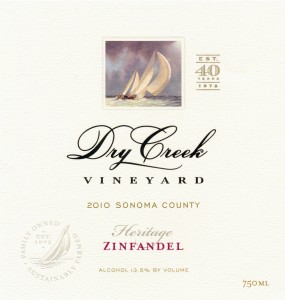 Zinfandel has been a cornerstone of
California winemaking since the 1850s when it was planted by
immigrants who came looking for gold. Since it's time for your Labor
Day barbecue, it's a good time to take a look at this quintessential
California wine.
Zinfandel has been a cornerstone of
California winemaking since the 1850s when it was planted by
immigrants who came looking for gold. Since it's time for your Labor
Day barbecue, it's a good time to take a look at this quintessential
California wine.
Zinfandel makes a deep purple wine with big, bold flavors of blackberry jam,
raspberry, strawberry and plum with spices like black pepper and
cinnamon.
Its a classic wine to pair with barbecue!
Zinfandel's origins can be traced back
to a Croatia grape called Crljenak Kasteljanski.
There is an Italian grape called Primitivo that is also a close relative of Zinfandel, and the wines are fairly similar.
There is an Italian grape called Primitivo that is also a close relative of Zinfandel, and the wines are fairly similar.
This grape makes aromatic,
rich, dark, full-bodied red wine with a higher than usual alcohol content.
Zinfandel wine gets that high alcohol because Zinfandel grapes like
to grow in hot climates.
Grapes grown in hotter climates get
riper and contain more sugar. The extra sugar means that after
fermentation the wines will contain more alcohol.
High alcohol does several things to wine:
- it adds a little tingle to the back of your throat.
- it increases the perception of body in the wine.
- accentuates the heat in spicy food.
Check the label when buying Zinfandel
and look for the percentage of Alcohol by Volume (ABV). A lower
alcohol Zinfandel (about 13.5% ABV) will have a lighter body than a
bold and spicy Zinfandel with 16% ABV. Higher alcohol Zinfandels will
also have more spice flavors, such as cinnamon and black pepper.
I like to look for Zinfandels with
about 14% ABV. If you find one with higher alcohol
than that, I'd suggest pairing it with food that is rich and not
too spicy.
Zinfandel is grown in several different
areas in California.
 The Sierra Foothills is the most
eastern area of grape growing. High elevation vineyards (like those
in El Dorado County) produce grapes with high acider, which leads to
wines that are easier to pair with food. They also may have a little
less fruitiness and a little more minerality than wines from
grapes grown on a valley floor.
The Sierra Foothills is the most
eastern area of grape growing. High elevation vineyards (like those
in El Dorado County) produce grapes with high acider, which leads to
wines that are easier to pair with food. They also may have a little
less fruitiness and a little more minerality than wines from
grapes grown on a valley floor.
Lodi is a large, flat area in the floor
of California's central valley (Modesto) that is home to large
production wineries.
Napa Valley is west of the central
valley, and is California's best known winemaking area. Napa makes great wine, and they also have great marketing.
Sonoma Valley is between Napa Valley
and the Pacific Ocean. The big temperature swings between day and
night get the fruit ripe, yet retain enough acid to balance the alcohol and make a more
food-friendly wine.
You can also find Zinfandel grown in
Paso Robles (near San Luis Obispo) and in Rancho Cucamonga (inland
from Los Angeles). Paso Robles Zinfandel will have a lighter body
than most other areas.
 Dry
Creek Heritage Zinfandel is from Sonoma County, is pretty easy to
find, costs about $15, and is a total crowd pleaser. Its a great introduction to Zinfandel.
Dry
Creek Heritage Zinfandel is from Sonoma County, is pretty easy to
find, costs about $15, and is a total crowd pleaser. Its a great introduction to Zinfandel.You'll get great fruit dark fruit (as opposed to red fruit) aromas with warm baking spices and smooth tannins.
Kenwood Vineyards Zinfandel is another good introduction to this wine.
- These two producers make great introductions to Zinfandel, and if you want to try more, then treat yourself to some Turley Zinfandel from Napa Valley. Turley makes several wines, the majority of which are single vineyard, old vine, organic Zinfandels.
- Old vines tend to produce smaller yields of fruit with more concentrated flavor, and single vineyard winemaking allows the wine to express characteristics unique to that little bit of property. Turley will run $40-$60, but its worth the splurge. But it might not be right for a big barbecue shindig.
-
- Enjoy your Labor Day weekend!



No comments:
Post a Comment